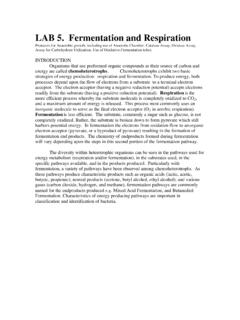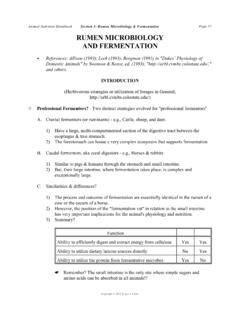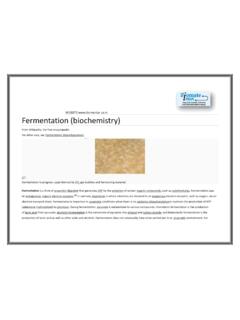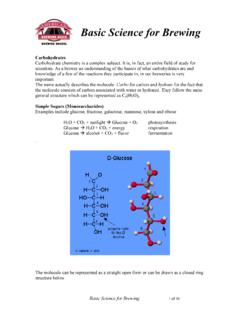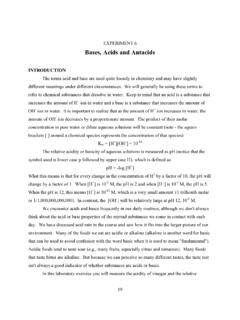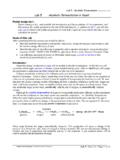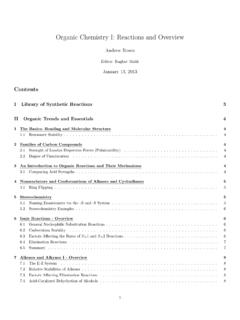Transcription of FLAVORS IN BEER - KotMF
1 FLAVORS IN BEERACETALDEHYDECHARACTERISTICS: Acetaldehyde has the flavor andaroma of green apples. It can also taste and : Formed as a precursor to alcohol by theyeast, or as a product of the oxidation of alcohol to : Acetaldehyde from yeast metabolism as a stepin the production of alcohol from glucose has a crispgreen apple flavor . If produced from the oxidation ofalcohol to acetic acid, whether by oxidation or byacetobacter, this flavor will be more vinegary and : As a product of yeast metabolism, it can becaused by the strain itself or by premature termination ofthe yeast's fermentation . The reaction from glucose toalcohol may be stopped at the acetaldehyde stage byfactors such as oxygen depletion, premature flocculation,etc. It may also be produced by contamination by aceticacid : Use a good yeast strain that will attenuatethe wort properly. Oxygenate the wort at yeast-pitchingtime.
2 DO NOT splash or oxygenate the wort whenracking or bottling. Long lagering periods will also : Both an aroma and a hot, spicy flavor detected by the nose as a vinousaroma and by the tongue by a warming sensation in themiddle of the tongue. A warming, prickling sensation inthe mouth and : The end product from the conversion ofglucose into carbon dioxide and ethyl alcohol. Other,higher alcohols can also be present, and these fusel oilsand contribute to vinous or solventlike aromas : A normal reaction desired in beer , alcoholcontent is a function of the amount of fermentable sugarsin the wort, the fermentation temperature, and the yeaststrain. Fusel oil production will be a function of the yeaststrain used and the fermentation temperature (highertemperatures give more fusel oils). Low levels of thedissolved oxygen during the lag phase may also promotethe production of higher alcohols due to themetabolization of fatty acids in the trub by the : Composition of the wort, yeast strain andfermentation temperature determines fusel : The amount of alcohol and fusel alcoholsshould be appropriate for the beer style.
3 Control alcoholby wort start gravity and wort content (avoid largeamounts of sugars). Wort should attenuate to about 1/4of starting gravity. Control fusel oils by reducing thefermentation temperatures and pitching adequateamounts of : Unlike bitterness, astringency ispresent as a stimulation of the nerve endings throughoutthe mouth. It is not an aroma. The taste has a puckering,dry, sensation reminiscent of grape : Bacterial or wild yeast contamination, addedastringency from grains or : Caused by: poor sanitation; excessivehopping; excessive wort attenuation (low dextrin content),which gives a greater perception of astringency; boilinggrains; excessive grain crushing; high spargetemperatures; over-sparging; letting beer sit too long ontrub; alkaline mash or sparge water; too much sulfate,magnesium or iron; excessively high : Process changes to eliminate the grain properly, watch mash/runoff pH, heat spargewater to a maximum of 170 degrees.
4 Practice goodsanitationCOLORCHARACTERISTICS: As appropriate for : Use of pale malts, use of sugar or adjuncts, : Use of higher-temperature kilned malts, use ofcrystal malt, use of dark malts, carmelization of the boil,hot side aeration and : Generally a desired characteristicof hop use. Bitterness will be tasted on the back of thetongue and the roof of the mouth. One of the four : Hop content and alpha strength; length of hopboil; presence of dark malts, alkaline : How long hops are boiled, type of hop, fermentation temperature (high temperature and quickfermentation decrease bitterness), filtration : Lower alpha hops, hops added at stagesthrough boil, filtration, high temperature : Mouth feel (will feel full). Asensation of viscosity in the : Caused by the presence ofpolysaccharides (dextrins) in the beer that are notfermentable by the yeast.
5 Medium length proteins alsocontribute to palate : Caused by presence of unfermentable sugarsor dextrins, often accentuated by : Desired in many beer styles. High-temperature saccharification rest in mash; use of crystalmalt and cara-pils malts; use of malto-dextrin, use oflactose, adequate protein rest, flaked wheat, oats orbarley in the : Generally not desired. Use of low-temperature saccharification rest in mash, highly-fermentable wort, use of large amounts of corn sugar inwort, long storage, bacterial breakdown, not boiling wortthat may have diastase enzymes : Visual clarity in beer contributes toits : Use of well-flocculating yeast strains;clearing agents such as polyclar, papain, Irish moss,bentonite, gelatin, etc.; filtration; long, vigorous boil andquick chilling; lagering and : Weak or mutated yeast strains, non-flocculant yeasts, wheat malt, unmalted barley, poor coldbreak, poor starch conversion in mash, poor malt crush,bacterial contamination, wild yeast contamination, highprotein content due to ineffective proteolytic rest(especially with undermodified malts), tannin present inbeer due to excessive or high temperature : The presence of carbonic acid inbeer gives the head and bubbles when the bottle isopened and pressure released.
6 Gives headcharacteristic. Taste is tart and acidic, increasing with thecarbonation. This is especially noticeable onovercarbonated brews. An overall prickly or stimulatingmouth feel. Small bubbles are desired, as these willretain both the head and the carbonation for a : CO2 is dissolved in beer during thefermentation MUCH: Excessive priming sugars, bacterialcontamination, presence of amylase enzymes in bottledbeer, iron or calcium oxalate in the water, isomerized hopextract, autolyzed yeast sediment, unconverted starch,not boiling extract worts, fusarium mold on barley or inextract, precipitation of excess salts in the LITTLE: Poor bottle cap seal, not enough primingsugar, weak or dead yeast culture when bottling (as withlong lagering periods or high alcohol beers).GRASSYCHARACTERISTICS: The aroma and flavor of fresh-cutgrass or new-mown : The aldehyde called hexenal, which isdetectable in concentrations of DUE TO PROCESS: Poor quality malt, poorstorage of malt, cracking grains well in advance ofbrewing.
7 Some English hops also contribute grassyaromas if used in large DUE TO PROCESS: Good, fresh maltstored under airtight conditions; cracking grains shortlybefore : A butterscotch aroma and flavor ,often a slickness on the palate. Not desired in excessivequantities, especially in : A by- product of yeast during fermentation , it isnormally re-absorbed during the secondary of yeast can produce respiratory deficient cellswhich have lost their ability to reduce the diacetyl to moreinnocuous compounds. Another cause is the gram-positive bacterium, Pediococcus Damnosus and otherlactic acid bacteria in cooled beer , young beer , and agingbeer. Note that the aroma/taste produced by all of thesecauses is : One of a family of vicinal recognized down to ppm, but identified ppm. Some tasters are unable to perceive diacetyleven in large RATES FROM PROCESS: Underpitching ofyeast; long periods of wort cooling (overnight);contamination from equipment; poor yeast strain; too-soon removal (fining) of yeast (before it can reabsorb thediacetyl); high adjunct ratio in wort; low fermentationtemperature; premature lagering; any process thatstimulates yeast then immediately removes it fromsuspension; use of contaminated sediment for re-pitching(bacteria often coexist with yeast in the sediment).
8 REDUCTION: Sanitation, quick wort chilling combinedwith adequate yeast starter amount (8 ounces of slurryper 5 gallons), adequate time for primary ferment beforelagering or fining/filtering, all-malt recipe, highertemperature primary fermentation , pure yeast culture,washing yeast sediment prior to AND RELATED COMPOUNDSCHARACTERISTICS: Volatile sulfur-based compoundsthat can give beer a taste and aroma of cooked corn,celery, cabbage or parsnip and even oystery-shellfish-likein high concentrations. These include dimethyl sulfide(DMS), diethyl sulfide, and di-isopropyl sulfide. DMS isfirst perceived in aroma at around 30 ppb, and the othercompounds at considerably lower concentrations. Thesecompounds are undesirable in beer in high : Wort bacteria (Obesumbacterium or Hafnia) isa major cause, especially of DMS. Coliform bacteriastrains can also give a strong cooked-vegetable , these compounds can be formed during thekilning of green malt and during mashing.
9 DMS is alsoformed by the yeast in a normal fermentation , and duringslow cooling of the wort by a non-microbiological LEVELS DUE TO PROCESS: Poor sanitation(primary cause); not boiling the wort for at least one hour;covering the brewpot during the boil, long cooling times(overnight) before pitching; underpitching; contaminatedyeast (especially packet yeast and recovered sediment);high moisture malt; over-sparging with water below : Good sanitation; fresh yeast culture; open,rolling boil; quick wort cooling; high pitching rates; use of2-row English malt; proper : Aromatic compounds that areidentified as fruity and estery in higher amounts. Theflavor and aroma of fruits such as strawberry, grapefruit,banana, raspberry, apple, pear and others can appear inbeer due to these esters. Depending on the style, thiscan be a desired flavor or one completely and high gravity beers are high in fruity-esterycontent, while pilsners and American lagers are : A by-product of fermentation produced bythe yeast.
10 Fruity-estery characteristics increase withfermentation DUE TO PROCESS: Yeast strain used,higher fermentation temperatures, fermenting some lageryeasts at temperatures above 50 degrees, DUE TO PROCESS: Yeast strain used,fermenting ales around 60 degrees or less, lagers around50 degrees or less, lower gravity IN BEERHEAD RETENTIONCHARACTERISTICS: Good head on the beer whenpoured, not excessively large or small, Belgian lace onglass, head remains for a several minutes. Very : Small bubbles, dextrins, medium molecularweight proteins, isohumulones from hops, nitrogen HEAD FROM PROCESS: Use of cara-pils; useof crystal malt; use of malto-dextrin; all-malt beer ; goodone hour rolling boil to extract the isohumulones from thehops; use of wheat malt; adequate protein rest in themash to allow the proteolytic enzymes to break down thelarge proteins into albumin and smaller fractions andincrease the nitrogen content; high-temperaturesaccharification rest; racking to secondary to get beer offsediment; lower temperature fermentation ; HEAD FROM PROCESS: Use of fully modifiedmalts; use of underkilned malts; not using a one-hour boil;inadequate protein rest, low-temperature saccharificationrest; oversparging; yeast autolysis from long sedimentcontact; excessive fusel oils; higher temperaturefermentation; excessive fatty acids.
